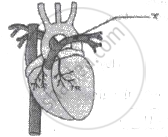Advertisements
Advertisements
प्रश्न
The diagram represents the ‘closed system’ or ‘double circulation’ of blood in mammals.
Justify the above statement.
State two structural and two functional differences between the arteries and veins.
State the changes in the composition of blood as it passes through the following organs:
(a) Lungs (b) Gut (c) Liver (d) Kidneys.
उत्तर
Double Circulation or closed system:
In human beings, the heart has double circulation as the blood passes through the heart twice.
(1) It first leaves the heart (right ventricle) and goes to the lungs and then returns to the heart (left auricle).
(2) From the left auricle, it circulates through the entire body and again returns to the heart (right auricle).
See Answer to Question 11, differentiate between.
(a) In the lungs, the blood releases carbon dioxide and picks up oxygen.
Hence before passing through the lungs, it contains more CO2 while it contains more oxygen after it has passed through the lungs.
(b) When blood passes through the gut, it absorbs digested food materials i.e., it contains more carbohydrates, proteins, fats, water, ions, and vitamins.
(c) As the blood passes through the liver, it contains more urea another waste materials.
(d) As the blood passes through kidneys, it contains less urea and other waste materials.
APPEARS IN
संबंधित प्रश्न
What is meant by the term 'single circulation'?
Put a tick mark (✓) against the correct alternative in the following statement:
Sphygmomanometer measures
- Pulse rate
- Heart beat
- Blood pressure
- Brain activity
What does the term ‘double circulation’ mean?
In the given diagram, 'X' indicates ______

In which of the following groups of organisms, blood flows through the heart only once during one cycle of passage through the body?
In which, blood circulation starts and ends in capillaries?
Oxygenated blood to the liver is supplied by ______.
Write important role/roles of the following:
Hepatic portal vein
Write the exact location of the following:
Hepatic portal vein
